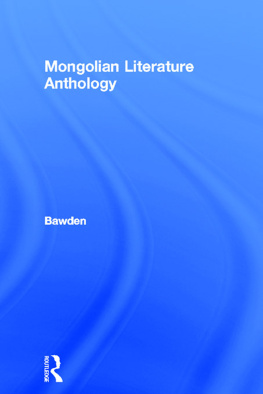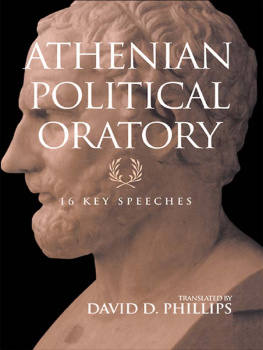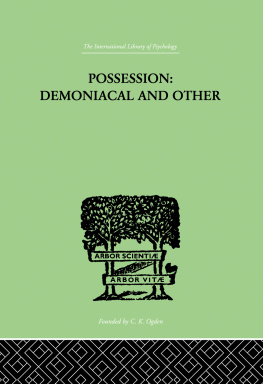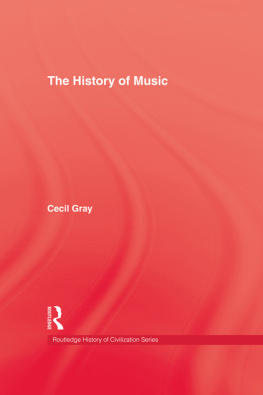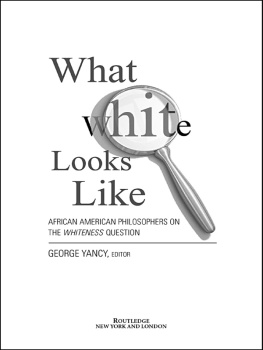THE MODERN HISTORY OF
MONGOLIA
First published in 1968 by
Kegan Paul International Ltd
This edition first published in 2009 by
Routledge
2 Park Square, Milton Park, Abingdon, Oxon, OX14 4RN
Simultaneously published in the USA and Canada
by Routledge
270 Madison Avenue, New York, NY 10016
Routledge is an imprint of the Taylor & Francis Group, an informa business
C. R. Bawden, 1989
Afterword, Kegan Paul, 1989
Transferred to Digital Printing 2009
All rights reserved. No part of this book may be reprinted or reproduced or utilised in any form or by any electronic, mechanical, or other means, now known or hereafter invented, including photocopying and recording, or in any information storage or retrieval system, without permission in writing from the publishers.
British Library Cataloguing in Publication Data
A catalogue record for this book is available from the British Library
ISBN 10: 0-7103-0800-0 (hbk)
ISBN 13: 978-0-7103-0800-9 (hbk)
Publishers Note
The publisher has gone to great lengths to ensure the quality of this reprint but points out that some imperfections in the original copies may be apparent. The publisher has made every effort to contact original copyright holders and would welcome correspondence from those they have been unable to trace.
For my wife
CONTENTS
ACKNOWLEDGEMENTS
For their kindness in permitting the reproduction of certain illustrations I would like to express my grateful thanks to the following:
For Plate I: Dr F. Herrmann and the Vlkerkunde Museum der J. und E. von Portheim-Stiftung fr Wissenschaft und Kunst, Heidelberg.
For Plate 10: Professor R. A. Rupen.
For Plates 19 and 20: The Royal Library, Copenhagen.
For Plate 21: Dr R. J. Hayes and the Chester Beatty Library, Dublin.
For Plate 36: Professor Owen Lattimore.
For Plates 43 and 47: Mrs Martha Boyer and the National Museum Copenhagen.
PREFACE TO THE SECOND EDITION
The text of the first edition has been reprinted without alteration, except for the correction of some errors and misprints, and the elimination of some anachronisms. Hence all statements, particularly those in the last chapter, should be read as applicable to the situation and the state of knowledge as they were in the mid-sixties. The main lines of development in Mongolia over the last twenty years are presented in the Afterword by Mr Alan Sanders, to whom the author wishes to express his thanks.
C. R. BAWDEN
Iver 1988
PREFACE
The Mongols are one of the great peoples in the history of High Asia. Their name has been familiar over the whole of the old world for close on eight hundred years. Yet at the most generous estimate it would be anachronistic to speak of a Mongol state, in the modern sense of the word, as existing before the end of 1911. The imperial adventure under Genghis Khan and his successors left the Mongols exhausted and disunited politically, and in the seventeenth century they fell, piecemeal, under Manchu domination which continued for over two hundred years.
Yet a feeling of belonging together, a sense of identity as the subjects and posterity of Genghis Khan, seems never to have deserted the Mongols, and this was one of two internal factors which helped to give them the vision and strength to recover their independence from the Manchus when the last imperial dynasty in China was swept away. The other factor was the spiritual unity conferred by the universal acceptance of the Buddhist faith in its lamaist form, and by the reverence accorded to the Jebtsundamba Khutuktu, or Living Buddha of Urga, the head of the lamaist hierarchy in Mongolia. Undoubtedly this continuing sense of community would have been nugatory had not the international interests of Russia demanded the survival, if possible, of an independent or autonomous Mongolia, to act as a buffer along part of the frontier with China. Mongolias inability to assure her own independent existence was clearly demonstrated, for instance, in 1919, when an aggressive China took advantage of the temporary impotence of revolutionary Russia to re-annex Mongolia. Nevertheless, had the Mongols not had the capacity for self-assertion, preserved under long years of subjection to an alien power, it would no doubt have proved impossible for the Russians to create and shore up for very long an artificial Mongol state.
Mongolias situation between two great world powers forces her to a greater degree of adaptation and acquiescence than might be the case if her geography were different. An indication of this is that her frontiers are arbitrarily drawn, especially on the south, and exclude more Mongols, especially within China, than they embrace. But it is of great historical interest that the Mongols were able to keep alive, first some sense of group solidarity and, later, their newly gained but precarious independence, until it became possible to stabilize their frontiers, to create from the rump of the nation a viable state, and to profit by the exaltation of nationalism in the middle of the twentieth century to achieve international recognition of this new Mongol state within frontiers agreed with their two neighbours. No other central Asian people has been able to do as much, and Mongolias present status compares very favourably with that of Tibet, whose historical development over the past two centuries is in many ways analagous to her own.
In the first half of this book I hope to have given a picture of Mongol society as it was during the comparatively static two centuries between the final submission to the Manchus in 1691 and the national revolution of 1911. The second part of the book describes the dynamic course of events since that revolution and more especially since the second, Soviet-inspired, revolution which began in 1921. For the past forty-five years Mongolia has been developing as the second socialist country in the world. Any attempt to study such a subject and such a period of history is fated to arouse controversy. Whatever opinions an author puts forward on a variety of topics, he will encounter dissent from one side or the other. The main point at issue will no doubt be the extent to which the Mongol revolution was a native growth and the extent to which it was a reflection of the interests of a foreign power, the USSR. It is impossible that at the outset the Mongol revolutionaries, whose purpose it was to enlist Russian support in expelling the Chinese and who enjoyed the confidence of the Living Buddha, can have envisaged the sort of control the Russians were to exert over their party only a few years later. This party included men of a wide range of opinion. As things turned out, the moderates were soon removed, but theoretical Bolshevism played only a negligible part in the first stirrings of the revolution in Mongolia. Nothing in Mongolias history presaged the rapid movement towards communism which took place after 1921 and more especially after 1929. There was no Mongol revolutionary movement until after the October revolution had taken place, and for the first eight years or so the most influential figures in Mongol affairs were Buriats of Soviet nationality. The Mongol revolution in general followed the pattern of events in Russia. In the form which it took it was determined more by events in the USSR and by direct Soviet intervention than by Mongol needs, and though of course it dealt with Mongol problems these were often tackled in a way imposed by Russia. This analysis will not be acceptable in all quarters, especially as it points up the extent to which Soviet actions abroad under Stalin belied the conviction of Marx and Engels that revolution and socialism should not be imposed from without. Understandably, the relaxation of Soviet monolithic control since the victory of Tito, the death of Stalin, and the emergence of communist China, has made an enormous difference to Mongolias situation, and in recent years she has been able to give effective expression, both at home and abroad, to her independence.



